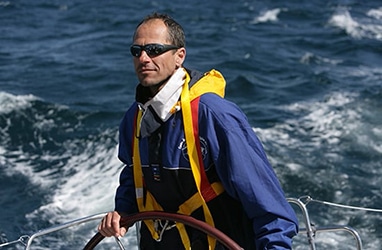Boat Safety Sound Signals
Sound signals are defined and prescribed in the Navigation Rules for International and Inland Waters. Sound has an advantage over light signals, in that it can be used when vision fails. The use of bells, whistles, gongs, horns, etc. can be valuable in many visually impaired conditions. However, the ideal horn is one that is pressurized and can be heard for a long distance. You may want to carry a couple of these as spares.
The Navigation Rules for International sound signals vary slightly from Inland Rules. Refer to the official document for proper use in your sailing area.
The purposes of sounding devices are many including alerting an oncoming vessel of your intentions, signaling an emergency, and identifying yourself in foggy and unclear visual conditions.
These audio devices should be located so they are readily available when needed. When using sound signals there are rules governing the sounding length of time and frequency (how often you send a signal). A short blast is to be one second long and a prolonged blast is to be between 4 and 6 seconds. Between each successive signal, you should wait 10 seconds or more.
The basic sound signals you should know are shown below where ![]() is a short blast on the horn (lasting 1 second).
is a short blast on the horn (lasting 1 second).
These sounds are to be made by power-driven vessels greater than 12 meters (39ft) in length when operating in a narrow channel and have sighted each other.
 I am altering my course to starboard
I am altering my course to starboard
-

 I am altering my course to port
I am altering my course to port


 I am running astern propulsion
I am running astern propulsion




 Danger
Danger
The danger signal is general and can be used by anyone to signal disagreement with another vessel’s signal, which may lead to danger or just danger in general to anyone.
When operating in areas of restricted visibility IE fog, a Sailboat must make the following signal.


 I am a sailboat in fog. Remember this: an average sailboat normally has two sails – thus the two short toots.
I am a sailboat in fog. Remember this: an average sailboat normally has two sails – thus the two short toots.
Where ![]() is a prolonged blast (lasting 4 to 6 seconds) and signals are not more than 2 minutes apart. This signal above (one prolonged and two short) is also the signal for other vessels operating in fog such as vessels towing, broken down, commercial fishing, or restricted in ability to maneuver.
is a prolonged blast (lasting 4 to 6 seconds) and signals are not more than 2 minutes apart. This signal above (one prolonged and two short) is also the signal for other vessels operating in fog such as vessels towing, broken down, commercial fishing, or restricted in ability to maneuver.
Power-driven vessels operating in fog must make the following signal not more than 2 minutes apart.
 I am a power-driven vessel in fog making way
I am a power-driven vessel in fog making way

 I am a power-driven vessel in fog stopped and making no way
I am a power-driven vessel in fog stopped and making no way
These are international rules. The above list of signals is not exhaustive. For a list of all sound signals visit Rules 32 through 37 of the USCG regs (which again are international).






